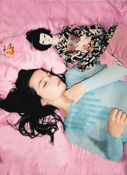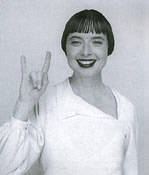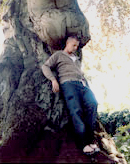 |
  |
 |
  |
 |
 |
| |

Read Bjork's2001 interview with Juergen Teller from the index archives. |

|
 |

Kathleen Hanna discusses writing and making music in this interview from 2000 with Laurie Weeks. |
|
 |
|
 |
|
|
 |

Isabella Rossellini spoke with Peter Halley in this 1999 interview. |
|
 |
|
|
 |
 |
|
Alexander McQueen's 2003 interview with Bjork. |
|
 |
|
|
 |
|
 |
MacDermott and MacGough, 2002 |
 |
 |
 |
 |
 |
WITH STEVE LAFRENIERE
|
 |
 |
 |
 |
 |
STEVE LAFRENIERE: Are you going to stay in New York for long?
DAVID MACDERMOTT: Because I don't travel by airplane, I stay for a while when I come. I took a boat in December and was caught up in terrible storms, a very bad passage. I haven't been here for two years, so I'll probably stay until the beginning of summer. That's a beautiful time in Ireland the days are so long.
STEVE: Earlier you were telling me how inspired you were by Richard Merkin.
DAVID: Yes, he was a professor at Syracuse when I was there in the late '60s. A famous dandy, and a friend of Tom Wolfe. He was also an illustrator who worked for Esquire and The New Yorker. I really emulated him when I first came to New York.
STEVE: Did you know what it was you were looking for?
DAVID: I was doing everything I could to make myself one of those afficianados who knew what was what. A lot of that has stayed with me. But even before I met Richard Merkin I was devoted to the past.
STEVE: When you were a child?
DAVID: Yes. I liked history. I liked wearing my Civil War uniforms, or acting out World War II. I liked being realistic. That was a test we had as children, if something was realistic enough or not.
STEVE: Sure, I remember that. What were your circumstances growing up?
DAVID: I was born in Hollywood. My parents had gone there to be screenwriters, but it didn't work out, so they moved back to New Jersey. Afterwords, I lived much of the time with my grandmother. Nearby to her were all these big old mansions, and I wanted to know why we didn't live in one of them. I remember finding this pink marble mansion in The New York Times real estate listings for "Ten Rooms or Over." It cost a million dollars to build in 1928, and was now only ten thousand dollars. I knew that was about the value of my parents' house, so I told them, "Look, I found a way out!" At the age of ten I had found a way for us to have a pink marble mansion for the same amount we paid for our little boxy house. That's when I discovered my parents weren't interested in raising their station.
STEVE: Were you often thwarted that way as a child?
DAVID: Yes. But some people would still consider me a child. I have an old physiognomy, but inside I'm still a little kid. I suppose a lot of my choices have not been adult-like.
STEVE: Since your work has so much homosexual subtext, the more knee-jerk critics categorize what you do as camp. Does that bother you?
DAVID: I've always thought of camp as a really low-level way for homosexuals to express their creative urges. For example, imagine that you go to high school in the Midwest. The piano teacher is bad, there's no ballet, all they get to do is go to some pep rally. Maybe they have an aunt, someone who exposes them to things a little bit. They begin to realize they're deprived of a cultural education. But instead of mocking up with cardboard the life that they want to have, they resign themselves to the fact that they've been defeated and make a culture out of laughing at the football players' uniforms. The kind of homosexual I am is one that strives to take that energy and channel it into something greater, something incredible rather than just laughing at Bette Davis.
STEVE: Do you have a short answer when people ask why you live in the past?
DAVID: When you look at the present through the mentality of the past, you're actually seeing it from a very refreshing standpoint. And if you try to understand new ideas through the framework of the past, you can see them for what they really are. Sometimes you can get to a place that nobody else can get to at all.
PETER MACGOUGH: You also very quickly realize what's great about the present.
DAVID: Nonetheless, the material world of the past was obviously put together much better than our present material world.
STEVE: Was it?
DAVID: The way that people dressed, their whole artistic reality from the lowest of the low to the highest of the high was superb. Maybe peasants in their cave houses with their wooden bowls didn't see it. But we can see from our viewpoint that it was a beautiful, beautiful world.
PETER: When you look at a Lewis Hine photograph of a slum tenement, it's much more attractive than a slum tenement now.
DAVID: We wouldn't mind living there. They had wallpaper, an iron bed in the bedroom ...
STEVE: Your photographs of outdoor sites are remarkable. A great deal of thought must go into every camera angle.
DAVID: If there are wires there, or a burglar alarm, we have to shift the whole scene over. So we get odd views of everything. When we started going to these sites, we realized how much ugly junk is everywhere.
PETER: Last Sunday we drove up to Mark Twain's house in Hartford. And right in front of this beautiful, perfectly restored building they had put a hideous, paved drive.
DAVID: The curtains were synthetic rayon! I wanted to experience the past there, but we only got to see someone's version with a lot of mistakes. All the gas lights had electric bulbs in them.
PETER: It's everywhere. I went to see Gosford Park. I loved the movie, but the laundry! Playing the butler, Richard E. Grant had perfectly starched linens. But the man who supposedly owned the estate had clothes that looked like they were pressed and spray-starched.
DAVID:The laundry is always wrong in these pictures.
PETER: [going into the next room and returning with a silk hand towel] Here's a perfect example of original starch. I was given this as a present from someone who visited France. You can see how shiny it is. Probably late nineteenth century. We've finally gotten our launderer to do it the way we want, but it's still only good-bad. You'd have to go to Russia or Eastern Europe to get it done correctly.
STEVE: How do you know these things?
PETER: From reading, and from people we know who pass it down. We had an incredible friend who knew so much, who also lived in the past.
DAVID: I made my first high collars out of paper and fastened them on with safety pins. I didn't know anything when I started. I would study period movies on television as if they were another world that I could enter. Then, when I went away to Syracuse, I found attics full of things. Once I got out of the suburbs I discovered that there were all these old cities that were packed with things, and that people were just putting them into the garbage.
PETER: But we weren't alone.
DAVID: We had a lot of friends like that. Some were very focused, like Robert Bryant, who's now the men's fashion editor at The Times. Most people don't know that he's a very disciplined devotee of the late '20s and early '30s. The baby boom produced a lot of children who were interested in the past.
STEVE: It's true, kids in the '60s were wearing Victorian and Edwardian clothes although they usually mixed them with jeans.
PETER: Right. The hippies saved the past and destroyed it at the same time.
STEVE: Are you missionary about your ideas?
DAVID: We used to be more interested in convincing people when we were younger.
PETER: You can't be missionary. People don't care.
STEVE: Yet so much of your work has a political subtext albeit put forth in a very lovely manner.
DAVID: Well, we aim our work at the art intelligentsia, but we also want to be able to show it to the ladies of the church. We are also obviously limited by our backdating of everything. We ingest the contemporary news, but then send it forward through the past to validate it on a whole other level.
STEVE: Some of your work is quite creepy. The Conspiracy Paintings, for instance.
PETER: Those are based on conspiracy theory books about politics, health, and religion that we've read.
DAVID: Some of it is Boswell, from Christianity, Social Tolerance, and Homosexuality.
STEVE: Your current interest in the Nazis has crossed over into the conspiracy area, too.
DAVID: I've been reading The Hidden Hitler by Lothar Machtan. I have a thoery that the second half of Mein Kampf is taken from four issues of Henry Ford's Independent magazine, wherein he published anti-Semitic diatribes. Hitler had it translated into German and just stuck it in there. Why don't we know this? Why isn't this common knowlege? Well, I think the Ford family made sure that it wasn't in our history books.
PETER: There goes our Ford Foundation grant.
DAVID: In Ireland we have a forty-foot-long by ten-foot-high painting of a Nazi eagle. It's horrifying. But when you get closer, you see that the whole background is conspiracy texts we've excerpted. It's everything you're never told about Pope Pius XII, how the Duke of Windsor was going to be the FŸhrer, that there were really only nine U-boats ... all this stuff.
STEVE: What were your sources?
DAVID: Conspiracy books. Economics books. Here, there. All I want to do is spark the intelligence, make the public feel like they're missing something. And if they want to say, "Oh, this is crazy conspiracy stuff," I don't care. They can think whatever they want.
STEVE: Your photographs have a very different feeling from the paintings.
PETER: Our photographs record our life, and our paintings are our ideas.
STEVE: But the photos are nineteenth-century subjects, such as the one of Jesus crucified.
PETER: That was Louise Bourgoise's assistant, Jerry. He's a friend of ours.
STEVE: Oh, they're portraits?
PETER: [looking through a book of their photos] Well, this was our dealer, Harry Lunn. This one was of Trevor Fairbrother's hands. This one was our boyfriend at the time, who had such a beautiful thin body. We called it God's Mercy.
DAVID: We got our start shooting all these little figurines that we collected. Julian Schnabel would come to our house and say, "You know what you ought to paint, man? You should just paint that vase over there. Your lives are beautiful. You don't have to work so hard! Just paint that bear rug!" So that's what we did with the photography, and we had immediate success.
STEVE: Some of the photographs actually look like Hollywood production stills. How difficult was that?
DAVID: Enormously. The more elaborate the photograph, the more we had to change reality. Street scenes with people and vehicles are very complicated, you know. So photography forced us to become even more old fashioned. But our organization got bigger and bigger, until we couldn't handle it any more.
PETER: We had fourteen assistants in the 1980s. We had a huge studio.
DAVID: Twenty-two-foot-high ceilings. We had five cameras. We had a darkroom where we could develop 20" x 24" negatives.
STEVE: The stories about you back then are legendary. Even living in Chicago, I would hear about your parties. And your vehicles. What were some of them?
PETER: We had a 1913 Model-T Ford, a '26 Ford truck, and a 1930 Graham Paige.
DAVID: We had a dog cart. We would travel over the Williamsburg Bridge from Brooklyn in our cart, with two dogs pulling us.
PETER: We also had a horse and carriage in Brooklyn. We rode through the black neighborhoods, the Hasidic neighborhoods ...
DAVID: And we owned a rickshaw, and an eighteen-passenger horse-drawn omnibus.
STEVE: My god. Did you ever leave New York?
DAVID: Sure. But it would take us six or seven hours to get upstate, where normally it would take two. We took the back roads, because we knew all these oddball people along the route. And we staged old-fashioned accidents, where Peter would get catapulted out of the back of the car and land on the ground. People would stop and say, "Should we call an ambulance?" And I would yell, "No! We're Christian Scientists!" [laughs] At one point we even investigated purchasing a bi-plane.
PETER: But we were a little nervous, because it had a Model-T engine.
DAVID: We had a wild life. There was a period when it looked like it would never end.
STEVE: In your personal relationship, are you interested in earlier concepts of love?
DAVID: [taking a hoop skirt form off the wall, standing behind Peter's chair and hanging it over his head] This art career is a cage to keep Peter. He was a twenty-one-year-old boy when I met him, and I wanted him as my boyfriend. I wasn't his type, so I said to him, "What is your goal?" He said he wanted to be an artist. So I said, "If you'll be my boyfriend, I'll make you a great artist." And by twenty-five he was on the cover of Artforum.
PETER: I'm a bird in a gilded cage. Because of our art career, we were saved from opening an antique store in Hudson and seeking out ... Fiestaware.
DAVID: Instead of our love ending after three years, we moved into another realm, more like being brothers. At that point, we found ourselves another boyfriend. There were three of us for six years.
STEVE: Even that is so Bloomsbury Group! Your lifestyle is a central part of your art living without electricity, wearing differently constructed clothes, reading only old literature. What discoveries have you made by doing this?
PETER: So many things. It's like voodoo. By surrounding yourself with certain objects, you cast a spell. It's like living a magical incantation.
DAVID: Here is a very simple example. One time, I was very ill and I was in our big feather bed. I could hardly move. But I had an occupation, which was to move from the flat part of the bed, up this mountain of feathers, to the cool area. And vice versa. I discovered how interesting my bed was. I could move myself into various territories, and have different types of rest and sleep. I pitied those poor, unfortunate people on a modern bed with their flat terrain.
STEVE: The way you live is usually looked at in terms of what you are without refrigerators, television, radio, etc. It's never talked about as a compelling, sensual experience.
DAVID: But it's not easy. Do you realize that wherever we go, we have to take everything with us? When I travel, I have to bring my food, my equipment, and all my amusements with me. The modern person can pretty much expect that the world they left will be on the airplane as well as where they land. When I travel, I have to do so with an entire world that doesn't exist anymore.
|
 |
 |
 |
[an error occurred while processing this directive]
| |